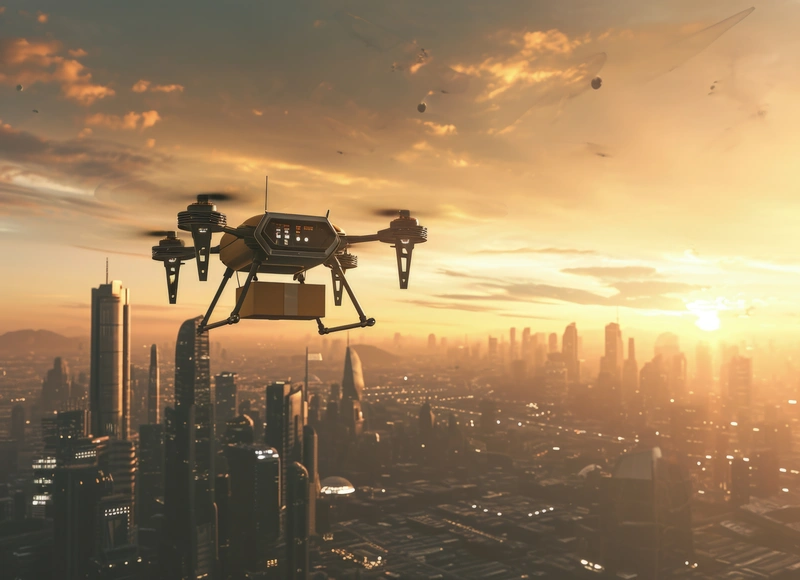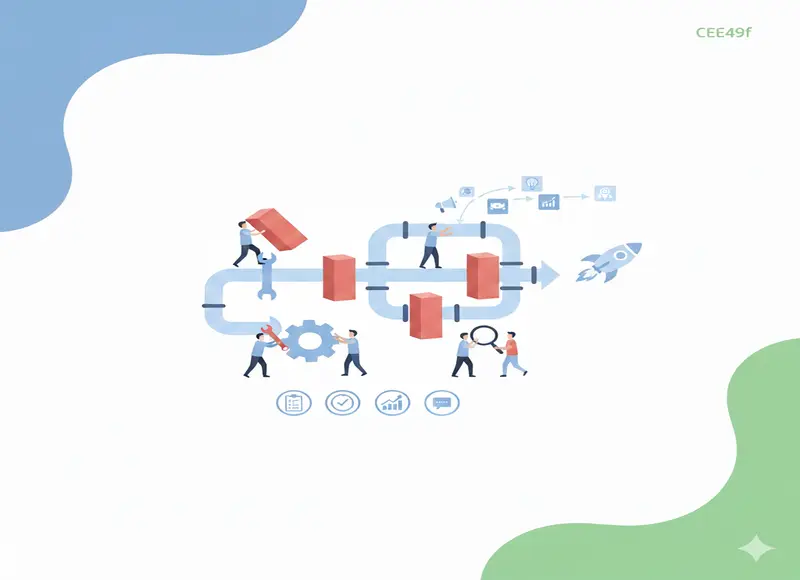Table of Contents
Discover the future of utility inspections with our AI-powered drones. These advanced drones enhance efficiency and accuracy, allowing for quick and thorough assessments of infrastructure. Equipped with cutting-edge technology, they can identify issues

AI-powered drones have revolutionized utility inspections. Gone are dangerous manual climbs and time-consuming visual checks.
With over 150,000 high-resolution images possible per mission, these flying machines detect failing equipment, uncover heat anomalies, and scan vast distances in record time.
For utilities aiming to optimize asset management and prevent outages, AI drones deliver results that keep the lights on and crews safe.
We’ll explore how AI drone technology amplifies inspection processes, the benefits for the utility sector, and the challenges companies might face.
Key Notes
- AI drones process inspection data in real-time, enabling immediate detection of equipment issues and failures.
- High-resolution cameras, thermal sensors, and LiDAR provide comprehensive infrastructure monitoring during a single flight.
- Weather limitations, battery life, and regulatory requirements remain key challenges for drone inspection programs.
What are AI-powered drones?
AI-powered drones are recognized as high-technology, unmanned aerial vehicles that do not have a human pilot on board.
These drones are designed with advanced technologies that enable them to carry out tasks from data collection and monitoring to full infrastructure inspections.
Here’s how they function:
High-Resolution Imaging
Most AI-powered drones have high-definition cameras installed, enabling clear, crisp images to be captured during a flight. Visual inspections of such assets as power lines, solar panels, or pipelines are significantly facilitated by this feature.
The drones provide clear visuals that help identify defects, wear, or damage that could pose safety or operational risks.
Sensor Integration
Beyond cameras, many drones incorporate various sensors (thermal, LiDAR, etc.) to gather a wealth of data.
For instance, thermal sensors detect heat anomalies that might indicate mechanical issues. LiDAR technology helps create precise, three-dimensional models of environments, offering insight into topographical changes or infrastructure conditions.
Autonomous Operation
AI algorithms qualify these drones to fly autonomously, without much manual input, in complex environments.
It makes planning and execution easier for operators as they predefine the flight paths for inspection, which also guarantees consistency and reliability.
Real-Time Data Processing
Among the attractive features of AI-powered drones is that they can analyze data in real-time.
Unlike traditional aircraft, which normally have to wait until after flying for data processing, drones allow immediate feedback.
Overview of AI Integration in Drones
Integrating artificial intelligence into drone technology amplifies their effectiveness, pushing the boundaries of what inspections and monitoring entail.
Here are some specific ways AI enhances drone capabilities:
Advanced Navigation
AI algorithms empower drones with the ability to map their surroundings, recognize obstacles, and adjust their flight paths in real-time.
The result? Enhanced safety and reduced risk of collisions, especially in environments with numerous physical barriers.
Machine Learning Models
AI drones use machine learning to enhance the quality of their inspections over time. They can learn to identify defects more accurately by analyzing past data and outcomes.
For example, if a drone finds some specific wear patterns in a particular component over repeated inspections, it can focus more on those areas in subsequent checks so that nothing critical slips by.
Predictive Maintenance
By analyzing trends and historical data from previous inspections, these drones can predict potential equipment failures.
This would help utility companies be proactive in solving problems that eventually end up in expensive repairs or can shut down operations.
Organizations can, on a significant level, improve asset management by adopting a model such as this.
Are Drones Artificial Intelligence?
Drones are aircraft that fly without a human pilot and can be controlled from a distance or fly autonomously. They have sensors and cameras that help gather data for tasks such as inspections and surveys.
On the other hand, AI is a subdiscipline of computer science intended to make machines capable of doing tasks that normally require human intelligence, like learning and decision-making.
Drones are not AI by themselves, but combining AI increases its capabilities immensely.
Using AI algorithms enables drones to conduct complex autonomous executions, analyze data in real-time, and offer predictive maintenance services. It just goes on to show the effect of AI, transforming drones with more effective operational efficiency for every application.
Relationship Between Drones and AI
Functionality vs. Intelligence
Drones serve as physical platforms for flight and data collection.
However, they become truly powerful when equipped with AI, which enables autonomous operations and enhances their ability to analyze collected data.
Without AI, drones can only capture images and cannot interpret them or react appropriately to the information.
Real-Time Decision-Making
The inclusion of AI enables drones to analyze data on the go and can identify any problems and needed adjustments right on the fly.
This real-time responsiveness transforms how industries manage inspections, as potential problems can be addressed swiftly before they escalate.
Collaboration with Human Operators
Although AI significantly boosts drone capabilities, human oversight remains essential.
Skilled personnel interpret the insights generated by drones, making informed decisions and providing context to findings. This collaboration ensures that the data collected leads to actionable outcomes.
Examples in Use
In utility inspections, for instance, AI drones can analyze thermal images to identify overheating equipment as the inspection occurs.
This proactive ability helps utility companies prevent potential failures, underscoring the effectiveness of combining drone technology with AI.
Key Features of AI Drones in Utility Inspections
AI-powered drones bring robust features that elevate their effectiveness in utility inspections.
Let’s break down the key capabilities that make these drones indispensable in modern asset management:
Enhanced Imaging and Data Collection Capabilities
High-Resolution Cameras
Most AI drones are outfitted with high-definition cameras that capture sharp images and videos of infrastructure. This clarity allows for detailed inspections of assets like power lines and substations.
But it’s not just about basic visuals; these cameras can operate in varying conditions, like low light or extreme weather, ensuring that inspection teams get reliable images regardless of environmental challenges.
Thermal Imaging
Besides ordinary cameras, many drones use thermal sensors to capture anomalies in temperature.
This technology is useful in identifying overheating equipment or electrical faults before they lead to failures.
For instance, a drone can rapidly scan a power transformer and identify areas that require maintenance.
LiDAR Technology
LiDAR, or Light Detection and Ranging, creates high-resolution, three-dimensional representations of the surroundings.
This is invaluable for infrastructure analysis since it would enable utility companies to scan their surroundings for potential vegetative intrusions, alignments, and possible dangers—attributes not discernible in basic visual inspection.
Multi-Payload Flexibility
Drones designed for utility inspections can carry multiple types of sensors simultaneously. This flexibility enables comprehensive data collection in a single flight.
Imagine a drone equipped with a thermal sensor, LiDAR, and a high-resolution camera gathering all necessary data points in one go—this efficiency streamlines the inspection process significantly.
Real-Time Data Analysis and Reporting
Instant Data Processing
Artificial intelligence technology in drones allows for real-time processing of data gathered, thus allowing businesses to react swiftly to actionable insights.
After a drone completes inspecting and identifying anomalies, insights are easily accessible, and businesses can make quick decisions in an effort to avoid issues.
Automated Anomaly Detection
Similar to machine vision systems applied in agriculture—where advanced algorithms decode imaging data to determine the health of crops and the requirements of resources—AI-powered drones can detect infrastructure irregularities in real time.
This analogy mirrors the inter-industrial use of AI technology and highlights the significance of precise analysis of data.
Such capabilities not only foster efficient operations but also drive better overall outcomes in inspections.
Data Integration
The data collected by AI drones can be integrated into existing asset management systems. This integration allows for seamless reporting, tracking, and analysis over time.
Utility companies can build a comprehensive database of inspections, helping them monitor changes and make informed decisions about maintenance schedules.
What Are the Advantages of AI Drone Systems?
Implementing AI drone systems in utility inspections offers numerous benefits.
Here’s how these innovations positively impact operations:
1. Increased Safety and Reduced Human Risk
Drone technology increases safety significantly by doing away with the need for inspectors to travel physically to areas that could pose risks, such as high-power poles or high-voltage cables.
Companies can eliminate the risks of manual inspections by adopting drone technology.
2. Operational Efficiency and Cost Savings
Drone inspection is accomplished at much quicker times compared to traditional manual inspection, allowing utilities to quickly address maintenance needs.
One such case study of a joint venture between an Australian utility firm and a drone service illustrated the advantage.
National Drones deployed advanced drone technology that conducted comprehensive inspections of power poles, generating approximately 150,000 high-resolution images. This detailed data collection facilitated faster decision-making and enhanced operational efficiency.
The transition to drone use allowed lineworkers to eliminate pole climbing, not only reducing the rate of accidents but also keeping them in line with occupational health regulations.
As a result, the utility company saved considerable costs by reducing manpower and optimizing uptime for critical assets.
3. Data Quality and Objectivity
AI drones capture high-resolution imagery, offering an objective look at infrastructure conditions that manual inspections cannot match.
The project with National Drones demonstrated that the unified database generated from drone inspections provided a holistic view of asset health, enabling better planning for maintenance and remedial actions.
4. Proactive Asset Management
Utility providers use the all-around data acquired during drone inspection to change the strategies of asset management from reactive to proactive.
With clearer pictures of their asset conditions, organizations can focus on maintenance based on priority, avoiding costly failures before they happen.
Potential Drawbacks of AI Drones
While AI-powered drones offer significant advantages in utility inspections, organizations must also navigate some potential drawbacks associated with their use:
Technical Challenges and Maintenance
Battery Life Limitations
The most obvious technical challenge related to drones is their short-lived battery life. Most commercial drones have a flight time of about 20-30 minutes per charge.
It also presents a limitation when inspecting extensive infrastructure such as long power lines or big solar farms.
Organizations may need to deploy multiple drones or plan for frequent recharges, which can affect efficiency and cost.
Weather Sensitivity
Drones are highly susceptible to adverse weather conditions. High winds, rain, or fog can hinder their flight stability and reduce the quality of captured data.
For example, flying a drone in high winds could lead to control issues or even crashes, while rain might obscure cameras, compromising inspection quality. Therefore, operators must monitor weather conditions closely to avoid delays and ensure safe operation.
Data Management and Interpretation
In addition, AI drones produce massive amounts of data after inspecting, which would be hard to interpret and manage. Specialized software and skilled manpower are needed to interpret the findings.
If not properly analyzed, critical insights may be lost, which actually reduces the entire effectiveness of inspection.
This requires companies to be equipped with the right systems and experts to manage this influx of information.
Technical Malfunctions
Like any technology, drones can experience technical failures. Some of these problems may arise from lost signals, GPS inaccuracy, or hardware failure.
Regular maintenance is also important to prevent operational disruptions as much as possible. However, routine maintenance could also incur added costs and time for companies in terms of its management.
Regulatory and Legal Considerations
Complex Regulatory Landscape
Strict rules set by aviation authorities regulate the use of drones for commercial purposes.
In the US, for example, the Federal Aviation Administration (FAA) oversees the operation of drones, among many other requirements, such as acquiring pilot certificates and following no-fly zones.
This can be very complicated to navigate, and organizations end up experiencing deployment delays while still ensuring that all legal requirements are met.
Operational Restrictions
Many regions have designated no-fly zones, especially around airports and densely populated urban areas.
These restrictions limit where drones can be deployed, impacting inspection coverage for companies operating in regions with complex airspace regulations.
Consequently, companies might need to schedule additional flights or choose alternate inspection methods for certain areas.
Liability Issues
Liability can be complex in the case of an accident involving a drone.
In case a drone crashes and results in property damage or injury, the company operating the drone will face legal consequences.
Organizations should take the necessary insurance coverage and follow proper operational procedures to help prevent liability risks.
Limitations in Complex Environments
Inability to Assess Structural Integrity
AI drones excel at capturing high-quality visual data, but they cannot physically assess the structural integrity of assets.
For instance, while a drone might identify cracks in a surface, it cannot determine whether those cracks compromise stability without a physical inspection.
This limitation underscores the importance of combining drone technology with traditional inspection methods to achieve comprehensive assessments.
Challenges in Urban Areas
Navigation through densely populated urban environments is a challenge for drones.
Obstacles such as buildings, power lines, and other infrastructure increase the risk of collisions during flight.
Additionally, such challenges might call for more advanced navigation tools and precise planning during flight, further complicating missions.
Drones may also have limited access to certain areas—this limitation may require further manual inspections, countering some of the efficiencies gained through drone use.
Limited Contextual Awareness
Drones operate based on predefined algorithms and can miss contextual information that human inspectors might readily identify.
For example, while a drone can detect a temperature anomaly on a piece of equipment, it may not have the intuition to assess the surrounding conditions that could affect performance.
This limitation means that integrating human expertise with drone technology is often essential for a complete understanding of asset conditions.
Conclusion
AI-powered drones have successfully demonstrated their value in utility inspections. Positive improvements can be seen in the safety, efficiency, and quality of data.
It provides a reduction in cost while allowing the systems to perform reliable, detailed inspections that would otherwise be difficult with traditional approaches.
Utility companies now have tools in their arsenal to move them from reactive maintenance to smart and preventive strategies by combining real-time analysis, advanced imaging capabilities, and automated anomaly detection.
Although there are weather limitations and regulatory requirements, the advantages of AI drone technology outweigh the disadvantages.
AI-powered drones are an accessible solution for utility companies looking to advance their inspection operations, thereby minimizing risks, saving time, and providing better output.
Take your utility inspections to the next level of modernization by introducing AI drone technology - your assets and bottom line will appreciate it.
Recent Blogs
Where Paywalled Content and Subscription Marketing Are Really Heading in 2026
-
16 Dec 2025
-
7 Min
-
82
How to Eliminate Bottlenecks in Your Marketing Agency Project Management Process
-
11 Dec 2025
-
7 Min
-
270







